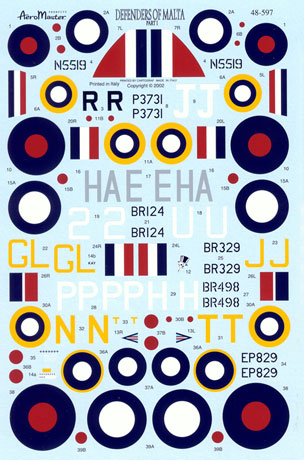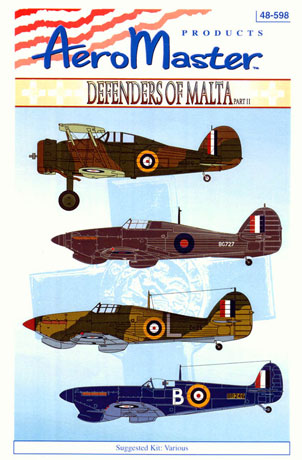S u m m a r y
|
| Catalogue
Number: |
AMD 48-597 and 48-598 |
| Scale: |
1/48 |
| Contents and Media: |
Waterslide decals plus instructions and notes |
| Price: |
USD$7.97 each from Squadron.com |
| Review Type: |
FirstLook |
| Advantages: |
Nice concept of "themed
sheets"; many, varied and unusual schemes; great value with large
number of options; perfect register; thin; minimal carrier film;
comprehensive stencil data; good instructions and background |
| Disadvantages: |
|
| Recommendation: |
Recommended |
Reviewed
by Rodger Kelly

Aeromaster's 1/48 scale
Defenders of Malta Part I and II
are available online
from Squadron.com
The air war in the defence of Malta island saw
some of the bitterest fighting of WWII. From an aircraft enthusiast’s
point of view it saw the employment of many different types of
aircraft and the use of many different colour schemes. AeroMaster
Products have bought some of the schemes worn by fighter aircraft
during the conflict to light in their two-sheet coverage of the epic
air battle.
Defenders of Malta Part I covers seven aircraft.
-
 Gloster
Sea Gladiator Mk I N5519 of the Fighter Flight, Hal Far in June
1940. The aircraft is finished in the Royal Navy Fleet Air Arm
scheme of extra dark sea grey/dark slate grey on the upper wings,
fuselage, fin and horizontal stabilizers, sea grey fuselage sides,
dark sea grey/light slate grey lower wings over black and white
under surfaces. Markings consist of type B roundels on the upper
surfaces of the wings, type D roundels on the under surfaces of the
lower wings, type C roundel to the fuselage sides, fin flash, with a
black serial and R squadron code letter. Gloster
Sea Gladiator Mk I N5519 of the Fighter Flight, Hal Far in June
1940. The aircraft is finished in the Royal Navy Fleet Air Arm
scheme of extra dark sea grey/dark slate grey on the upper wings,
fuselage, fin and horizontal stabilizers, sea grey fuselage sides,
dark sea grey/light slate grey lower wings over black and white
under surfaces. Markings consist of type B roundels on the upper
surfaces of the wings, type D roundels on the under surfaces of the
lower wings, type C roundel to the fuselage sides, fin flash, with a
black serial and R squadron code letter.
-
Hawker Hurricane Mk I P3731 flown by
Pilot Officer “Jock” Barber of the Fighter Flight at Hal Far in
August of 1940. Finish is dark earth/middle stone over azure blue
with a black spinner. Markings consist of type B roundels for the
upper wings, type D roundels for the lower wings, type C roundels
for the fuselage, a black serial number, a fin flash and a white
letter J squadron code. These markings are the same as provided by
Hasegawa in their 1/48 scale Hurricane Mk 1 Trop kit.
-
Hawker Hurricane Mk II b (serial
unknown) as flown by Pilot Officer Bill Hollis Hassett of 261
Squadron in 1941. The aircraft is still in its temperate scheme of
dark earth/dark green over sky with a black spinner and had yet to
be re-painted in the desert scheme and have its tropical filter
fitted. Markings consist of type B roundels for the upper wings,
type D roundels for the lower wings, type C roundels for the
fuselage, a black serial number, a fin flash and medium sea grey
squadron codes of HA-E. Artwork in the form of a top-hatted skull
is worn on the right hand side of the nose. The placement guide
states that this aircraft was called “Death Warmed Up” but offers no
explanation why.
-
Supermarine Spitfire Mk Vc Trop BR124
of 603 Squadron in 1942. This is one of the often mentioned and
hotly debated “Blue Spitfires” of Mata. The popular belief is that
these aircraft’s upper surfaces were painted in US Navy deck blue
whilst en-route from the UK to Malta aboard the USS Wasp. Called
Operation Calendar, it was a bold plan that used US carriers to
re-enforce Malta’s strength of fighter aircraft by flying them from
the carriers when they were within flying range of the island. The
undersides were still in azure blue and the spinner was black.
Markings are type B roundels on the upper wings, type D roundels on
the undersurfaces, type C roundels on the fuselage, black serial, a
fin flash and a white squadron code letters U-2.
-
Supermarine Spitfire Mk V b Trop BR329
flown by Flight Lieutenant Johnny Plagis of 185 Squadron from Kendri
in June 1942. Finish is in the desert scheme of dark earth/middle
stone upper surfaces over azure blue undersurfaces with a black
spinner. Markings are type B roundels on the upper surfaces of the
wing, type D roundels on the undersurfaces of the wing, type C
roundels to the fuselage, a fin flash, a black serial, yellow GL-J
squadron code letters, a “scoreboard” of 11 swastikas on a white
background and the word KAY on a yellow background.
-
Supermarine Spitfire Mk V b BR498 flown
by Wing Commander Peter Prosser Hanks from Ta Qali in October 1942.
Finish is in the desert scheme of dark earth/middle stone upper
surfaces over azure blue undersurfaces with a red and white
spinner. Markings are type B roundels on the upper surfaces of the
wing, type D roundels on the undersurfaces of the wing, type C
roundels to the fuselage, a fin flash, a black serial, white PP-H
codes (a privilege afforded to Wing Commanders in the RAF was to
have their initials painted on their personal aircraft – hence the
PP-H standing for Peter Prosser Hanks) and a Wing Commander
pennant. Note that this aircraft has had its Volkes filter
removed. It was also apparently waxed to a high sheen in an attempt
to gain speed.
·
Supermarine Spitfire Mk Vc Trop EP829 as flown by the
Commanding Officer of 249 Squadron, Squadron Leader John Lynch.
Finish is in the desert scheme of dark earth/middle stone upper
surfaces over azure blue undersurfaces with a black spinner. Markings
are type B roundels on the upper surfaces of the wing, type D roundels
on the undersurfaces of the wing, type C1 roundels to the fuselage, a
fin flash, a black serial and yellow T-N squadron code letters with a
smaller T added to spell out TNT, a “scoreboard seven German
Balkenkrauz and the words MALTAS 1000TH to commemorate
Lynch’s downing of the 1000th enemy aircraft on 28th
of April 1943.
Click
the thumbnails below to view larger images:
48-498 is Part II and it continues the
unusual paint schemes and also covers seven different aircraft.
·
 Gloster
Sea Gladiator Mk I N5520 of 261 Squadron based at Luqa in 1941.
Finish is dark green/dark earth over sky. Markings are sparse and
confined to type B roundels on the upper surfaces of the wings, type D
roundels for the under surfaces of the lower wings and type national C
roundels for the fuselage, the serial number for the rear fuselage and
a fin flash. Gloster
Sea Gladiator Mk I N5520 of 261 Squadron based at Luqa in 1941.
Finish is dark green/dark earth over sky. Markings are sparse and
confined to type B roundels on the upper surfaces of the wings, type D
roundels for the under surfaces of the lower wings and type national C
roundels for the fuselage, the serial number for the rear fuselage and
a fin flash.
·
Hawker Hurricane Mk IIb BG727 of the Malta Night Fighter
Unit, September 1941. Finish is overall Night (semi-gloss black) with
type B roundels in six positions, a white serial number and a fin
flash.
·
Hawker Hurricane Mk I Z4189. The finish is believed to
be dark green/middle stone over sky blue with a red spinner. Markings
are type B roundels for the upper wings, type D roundels for the lower
wings, type C roundels for the fuselage, a black serial number, a fin
flash and a medium sea grey letter L squadron code. This aircraft
also sports artwork in the form of a stylized black and white bomb
that is painted on the right hand side of the fuselage underneath the
cockpit.
·
Supermarine Spitfire Mk Vc Trop BR246 in 1942. Another
of the infamous “blue Malta Spitfires”. Finish is blue upper surfaces
and spinner over azure blue undersurfaces. Markings are type B
roundels on the upper wings, type D roundels on the undersurfaces,
type C roundels on the fuselage, black serial, a fin flash and a white
letter B ferry code.
·
Supermarine Spitfire Mk Vb Trop BR471 of 126 Squadron Ta
Qali in 1942. Finish is in the desert scheme of dark earth/middle
stone upper surfaces over azure blue undersurfaces with a red
spinner. Markings are type B roundels on the upper surfaces of the
wing, type D roundels on the undersurfaces of the wing, type C1
roundels to the fuselage, a fin flash, black serial and medium sea
grey PM-K squadron code letters.
·
Supermarine Spitfire Mk Vb Trop EP706 of 249 Squadron in
1942. This aircraft is the one flown by the well-known Canadian,
Pilot Officer George “Screwball” Beurling Malta’s top scoring ace.
Finish is also in the desert scheme of dark earth/middle stone upper
surfaces over azure blue undersurfaces with a black spinner. Markings
are type B roundels on the upper surfaces of the wing, type D roundels
on the undersurfaces of the wing, type C1 roundels to the fuselage, a
fin flash, a black serial, yellow T-L squadron code letters and a
“scoreboard” of 20 German balkenkreuz.
·
Supermarine Spitfire Mk Vc Trop JK879 of 249 Squadron.
Finish is in the desert scheme of dark earth/middle stone upper
surfaces over azure blue undersurfaces with a black spinner. Markings
are type B roundels on the upper surfaces of the wing, type D roundels
on the undersurfaces of the wing, type C1 roundels to the fuselage, a
fin flash, a black serial and yellow T-B squadron code letters, a
“Saint” stick figure and a “bomb log” consisting of 25 red and yellow
bombs.
Click
the thumbnails below to view larger images:
The decal placement guides for both sheets are
A-4 sized with full colour left hand side profiles of each aircraft on
the front with appropriate plan views of the upper and lower wings on
the rear. The artist has paid attention to detail with each of the
Hurricanes and Spitfires being correctly rendered with its appropriate
type of spinner.
The sheets also give a fairly comprehensive list
of references and helpful notes to the painting and detail differences
on each aircraft as well as a list of suggested kits.
A further book you might like to add to the list
is the Modelaid publication Air War Over Malta Part One – The Allies
by Frederick R Galea and Richard J Caruna. The list suggests the use
of the Airfix Mk Vc kit. Be aware that Garvia have also announced the
upcoming release of a Mk Vc in their range as well.
The decals themselves have been printed by
Cartograf, in Italy. No problems here, they are all in register (even
Beurling’s tiny scoreboard). They are sharp and clear and have
minimal carrier film. The decals and placement guides are packaged in
clear plastic ziploc bags.
These sheets offer great value. You can build a
Gladiator, a Hurricane, and two complete Spitfires from the Part I
sheet and a Gladiator, two Hurricanes, and two complete Spitfires from
the Part II sheet without looking for markings from elsewhere.
No doubt there will be robust discussion with
regard to some of the interpretations of the colour schemes amongst
the fans RAF aircraft but heck that’s half the fun of it!
Hopefully, these two sheets will sell well and
tempt AeroMaster into producing further “themed” sheets.
Recommended |
Home | What's
New | Features
| Gallery |
Reviews | Reference
| Forum
| Search